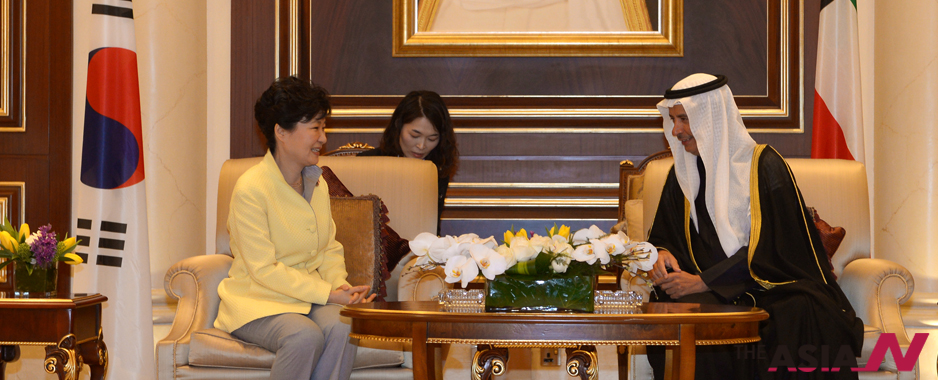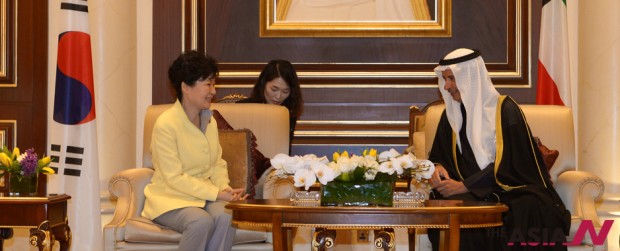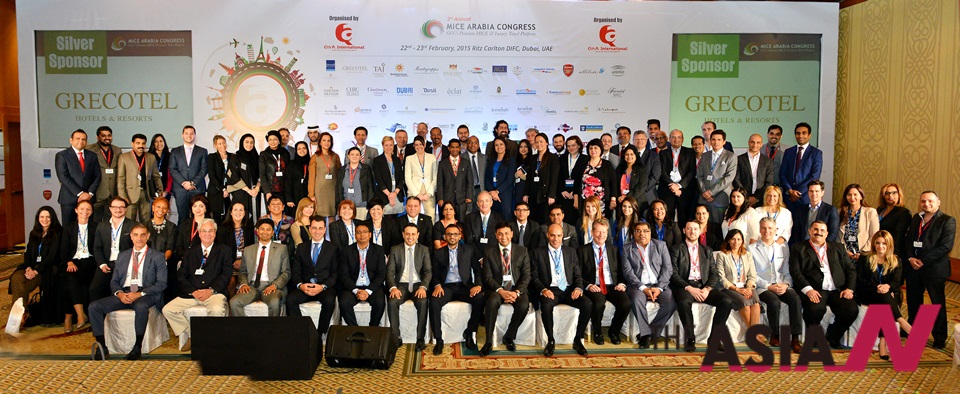
Kuwait & South Korea Relationship beyond Oil

A sincere and warm welcome was given to the South Korean President Park Geunhye, on her three-day official visit to Kuwait. The visit was on an invitation from His Highness the Amir Sheikh Sabah Al-Ahmad Al- Jaber Al-Sabah, who himself attended the Korean leader seen off ceremony at Kuwait international airport , with HH the Crown Prince Sheikh Nawaf Al- Ahmad Al-Jaber Al-Sabah, Speaker of the National Assembly Marzouq Al-Ghanim, HH the Prime Minister Sheikh Jaber Al-Mubarak Al-Hamad Al-Sabah, First Deputy Prime Minister and Minister of Foreign Affairs Sheikh Sabah Al-Khaled Al-Hamad Al-Sabah, Deputy Minister of the Amiri Diwan Sheikh Ali Jarah Al-Sabah, in addition to senior officials from the army, police, and Kuwait National Guard.
The obvious importance given to the South Korean President reflects the ambitious goals both sides plan depending on each other. Released by the Kuwaiti official news agency , KUNA, Kuwait and South Korea signed three agreements and memos of understanding in presence of His Highness the Amir Sheikh Sabah Al-Ahmad Al-Jaber Al-Sabah, visiting South Korean President Park Geun-hye, and the high level members of the two states, including First Deputy Prime Minister and Foreign Minister Sheikh Sabah Al-Khaled Al-Hamad Al- Sabah and South Korean Foreign Minister Yun Byung-se.
Kuwaiti Minister of Health Ali Al-Obaidi and South Korean Minister of Health and Welfare Moon Hyung-pyo also inked a memo of understanding in the field of health. Another memo of understanding on bilateral land transportation cooperation was signed by Kuwaiti Minister of Communications and Minister of State for Municipal Affairs Essa Al-Kandari and South Korean Vice Minister of Land, Infrastructure and Transport Yeo Hyung-ku.
Kuwait Petroleum Corporation (KPC) and South Korea’s Korea National Oil Corporation (KNOC), SK Gas Co and Kia Shore Company inked three memos of understanding (MoU). They were signed by KPC CEO Nizar Al- Adsani and Kuwait Petrochemical Industries Company CEO Asaad Al-Saad and the chairmen of the three Korean companies, the KPC said in a press release. Before the signing of the deals, Minister of Oil and Minister of State for National Assembly Affairs and KPC Board Chairman Ali Al-Omair received in his office visiting South Korean Minister of Trade, Industry and Energy Yoon Sang-jick, it said.
Just under half of the world’s top ten net oil importers come from emerging Asia, South Korea is the 6th largest net oil importer.
Korea’s energy consumption levels have increased over time and, given that its production capacity is relatively low and rigid, its energy imports have been rising. Nearly half of Korea’s energy use is in the form of petroleum, making the Gulf Cooperation Council (GCC) South Korea’s main source of imports for over a year now, exporting over $98 billion worth of goods in the 12 months prior to July 2013 – or 20% of South Korea’s total imports, its highest share since the 1979 oil crisis.
Among the GCC countries, Saudi Arabia is the largest exporter to South Korea and fifth at the global level. Saudi shipped $37.5 billion worth of goods in the 12 months to July 2013, followed by Qatar with $26 billion, Kuwait with $18.4 billion and the UAE with $16.2 billion. Kuwait became South Korea’s third largest exporter from the GCC in 2011.
The President Park visit to the four Gulf states focuses the importance of South Korea as an important economic partner. Currently Saudi Arabia leads exports more than the rest of the Gulf to South Korea. However, the GCC should adopt a strategy of diversification. About a third of South Korea’s energy consumption comes from coal (being the world’s largest producer, China is the main supplier) and another third comes from nuclear and natural gas. South Korea is the world’s second largest importer of liquefied natural gas, and its demand is rising fast, benefiting Qatar. Kuwait has a large quantity of proved natural gas reserves, the 18th biggest in the world, but produces very little. The economic center of the world is shifting East, and the Gulf’s oil producers should get prepared to cater for Asian needs if they want to get a piece of that pie.
When I visited KPC, I was introduced to its history, present and future. Since its incorporation, the company engaged in different activities of the oil industry. When it was established in 1960 KNPC was the only and first national company in a region where hydrocarbon resources were managed and exploited by foreign companies. The owners’ vision was a stimulating development and provided an exemplary experience in handling national resources.
In 1975 the State acquired full ownership of KNPC and compensated the private shareholders for their stocks. KNPC’s operations were highly integrated mainly relying upon its oil refinery in Shuaiba and the marketing of petroleum products from Al-Ahmadi Refinery, run at the time by Kuwait Oil Company KOC- in both Local and international markets. As a matter of fact KNPC at that time was maintaining an efficient presence in Europe, the Far East and United States of America to handle the marketing of petroleum products from the Kuwait refineries. It even owned and operated a number of oil tankers to deliver petroleum products to customers all across the world.
In 1980 Kuwait Petroleum Corporation (KPC) was established as the state owned asset and all other oil companies in Kuwait, including KNPC, became KPC subsidiaries. One year later after the establishment of KPC, the oil sector in Kuwait was restructured on sectorial basis. In collaboration with KPC the company embarked on studies and plans to modernize refining industry in Kuwait with a multi-billion dollar projects to revamp Mina Al-Ahmadi and Mina Abdullah Refineries.
By the year 1984 Mina Al-Ahmadi Refinery Modernization Project (RMP) was completed. It was then supplemented by the Further Upgrading Project (FUP) in 1986. On the domestic scene KNPC continued to build new filling stations in order to add more outlets for products marketing and to respond to the growing demand for gasoline and other fuels. However, KPC and KNPC put into effect the trend towards privatization and started in 2004 to transfer its Local Marketing assets, such as the lube oil plant and the petrol stations, to private companies. By the year 2009 the percentage of Kuwaitis in the total manpower was around 79.5% from the company labor force which totaled 5235 employees.
I was also introduced to the Clean Fuel Project (CFP), as one of the strategic projects of Kuwait National Petroleum Company which aimed at upgrading and expanding the existing KNPC two refineries at Mina Abdulla and Mina Al-Ahmadi. Total refining capacity of this complex after the CFP completion will go up to 800,000 barrels a day. Work progress is going as per the set plan, and the updated and sanctioned budget for CFP is KD 4,680 million. It is set for completion in 2017
I am focusing on the Oil scene as it is considered the main income resource. With the slashed oil price, developed countries such as South Korea is seen to help open new and different income resource and this could be technology, media and education. Neighbors like Qatar and UAE have found the way to import western education into the local communities; multi-languages and multi-billion educational universities and schools were established for the last two decades, as they offer citizen students with advanced education without the need to leave their families for similar chances abroad.





